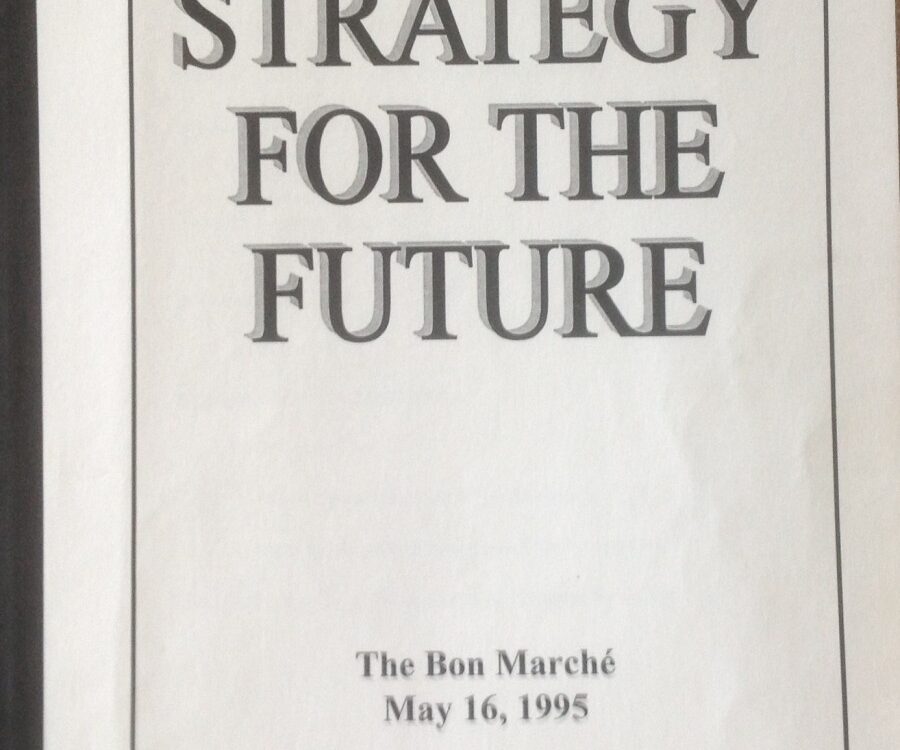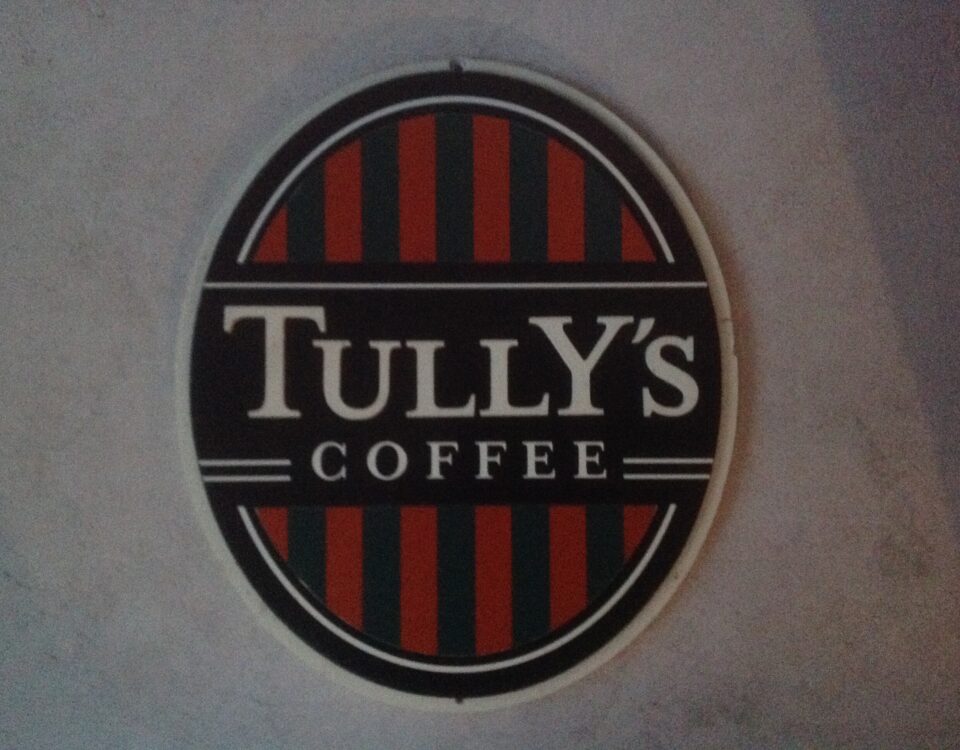
INDIVIDUAL EVENT STRATEGIES The Bon Marche 1995
January 18, 2012
The Split Culture– The Bon Marche’s Delimna 1996
January 18, 2012The Bon Marche’s Modified Marketing Strategy
as of 12/06/95
“THERE IS NO FINISH LINE”
Opening:
With the explosive change in the retail environment throughout 1995, The Bon Marche is experiencing tremendous pressure to maintain its profit margins. The pressure is coming from increased competition, changes in consumer habits, and the never-ending pressure on the expense side of the business.
The marketing and sales promotion division has been asked to re-engineer itself to gain greater efficiency, as well as expense savings, while retaining at least the same level of effective media to drive the business. This document was created to ensure a clear understanding of how the sales promotion division took on this challenge and to define the basic strategies that will serve as the marketing direction for 1996.
The Bori Marche Challenge:
The Bon Marche is struggling to re-define itself in the face of four very distinct market dynamics:
I. The Quantity and Proximity of New Retail Space:
Over the last four years, the greater Seattle area has continued to sprawl with the high growth areas being further and further from primary freeways. The developers have continued to build retail space closer to those customers. The home improvement business has grown by 12.0m sq. ft.; the electronics industry by 2.0m; the general retail by over 3.Om sq. ft. and all this space has been developed closer to the new housing starts.
2. Discount Operations:
The vast majority of this retail growth has been low-capital investments with very price-sensitive inventory offerings. These low expense operations are continuing to build on the theme “don’t pay department store prices.” The irony of our promotional high/low formula is that we establish the regular price for our inventory as well as everyone else’s. The customer has become increasingly value conscious.
- Differentiation Continues to be a Problem:
Most major manufacturers have opened their own outlet locations adding to the problem. Exclusivity in general brands is a thing of the past. There is even a question on commodity products that have mass distribution, i.e. Docker’s. Can the consumer be convinced that a special price offering is worth reacting to? Ifyou don’t need something, don’t buy it.
- Customer Loyalty has become a Ve1y Difficult Concept to Define and Maintain. The population is being split into two distinct groups. Older people tend to be more loyal, but as congestion worsens, convenience (as defined by time) continues to erode this form ofloyalty. Younger people have grown up with a greater number of options to buy merchandise and are less loyal than their parents. With the growth of the internet, it is possible to envision a future that continues to fragment the consumer into smaller and smaller buying groups.
These four conditions are working in all areas of retail, from medical to restaurants. In order to re-define our strategy, I believe the upscale food store (i.e. QFC) may be the model for our future. Because of the high inventory turn over, the food business has always been fast to react to consumer demands.
A brief description of the QFC strategy may offer some insight to the key operational issues for the future. The food business has always been very price sensitive with large national brands driving name awareness and individual stores dealing with the problem of high competitive pricing structures to hold customer counts. The quality of the product is highlighted by the nature of the freshness and obsolescence of much of the product. The customer has also added a demand for organic and environmental products to make the overall assortment a large part of the traffic count question.
Customers remain loyal as long as they feel that the experience is consistent and the quality is high while at the same time the pricing is competitive. We all know that the same basket of goods will be cheapest at Safeway, better quality and a little more expensive at QFC, with the most distinction — best quality, most selection, and highest price — at Larry’s Market.
I contend The Bon Marche must become the QFC of the general retail business. QFC’ s success stems from a series of factors that we must look at to remain competitive in a fast changing retail environment.
QFC has always been known for quality. This reputation was built on having distinctive product in key food areas. Their deli, fish, meat, produce, and bakery departments have always carried top-of-the-line product, staffed with specialists that know their product and act as their own private shop keepers. Their boxed and commodity products have always been competitively priced. The principal idea of high-end product in essential fresh areas, blended with competitively priced boxed goods, is now consistent throughout the industry.
Larry’s takes this concept and has expanded the assortment of the better products but this has limited the demographic areas to locate stores. Fred Meyer has taken this same concept into the price sensitive areas and expanded its offering of commodity boxed product. QFC defined the basic model and both the upside of the market as well as the lower end of the market is doing the same thing. The QFC stores are easy to shop.
People like to go where they can easily find the product and merchandising is held to a minimum. The QFC staff is friendly and bright. The Safeway experience, the QFC experience and the Larry’s experience are all friendly. Larry’s staff is the most knowledgeable.
Loyalty of specialty products is built around encouraging people to sample the product. Customers are built one product at a time, one customer at a time. These customers become loyal to the product first, then the quality of the specific department, the convenience factor, consistency, and the belief that they generally receive a fair value on a weekly basis.
The food business has the same customer as The Bon Marche. I believe the best vision of our future comes from interpreting what QFC is doing to grow its business and re-defining our key drivers in light of this perspective.
Key Seasons:
Our efforts have been historically built around perceived key customer seasons such as the Home Sales in February and August, our major spring and fall sales, Mother’s Day, Father’s Day, Back-to-School, Thanksgiving, and Christmas, as well as the clearance seasons of June/July and January/February. Our objective was to dominate these
customer selling seasons with a three-and-a-half week strategy that developed all parts of the business into a consistent theme and established us as headquarters for the consumers’ needs.
I no longer believe that this strategy is the dominant factor in driving success and increasing market share. The reality is that the consumer is buying closer and closer to their need. Creating urgency prior to the period just before the given holiday or activity is no longer possible. Customers have too many choices, and they simply don’t care.
The major seasons still represent key messages that need to be developed, but we can no longer distort the money we spend to dominate the season and get a return on the investment. Our strategy must stop increasing our expenditures to promote these seasons at the expense of other messages. We must re-invest some of the funds into those areas of the business we can gain greater market share at profitable margins.
Promotional Strategies:
Maintaining a weeldy promotional calendar means that the consumer no longer believes that our basic goods have a regular price — 25% off is perceived as our regular price. This frequency of promotional beat and this customer disbelief in regular price has caused a problem in creating urgency, which was a critical factor in our promotional formula. “Get it now, because it will cost more later,” has been changed to, “The longer you wait, the cheaper it will get.”
To counteract this issue, we have created four new additions to our promotional concepts to stimulate customer activity:
1. Leader Items:
This concept is most common to the grocery store model with their concept of end cap merchandising (pop for 99¢). We must offer compelling values to our customer or they will not respond.
2. Point Of Sale Markdown of Clearance:
The customer still understands clearance, so “Save 30-50% POS Markdown of Clearance” still has meaning. We must be careful not to play too many games with “Just Reduced” and all of clearance.
3. Deals:
Deals are the extra 10% or “Bonus Bucks” or “Gift with Purchase” type activity that we use for courtesy days on our major events.
4. Added Value:
Added Value refers to things like free alteration, free parking, free gift wrap, etc. We have tended not to use this type of promotion because we view it as an expense and, operationally, we are no longer prepared to handle some of its issues.
Pricing Strategies:
With the increase in our promotional beat, our pricing strategies are under severe pressure. How often a particular item is offered for sale and at what price the item is offered have become major concerns. The general rules for 1996 are:
- An item must be at its regular price at least 50% of the time.
- The item can be offered for sale at a promotional price only once every 7 days and, that if the sale price is offered every 7 days, it must be offered at the same sale price.
- Ifthe item is to be offered at a lower price, there must be at least 14 days between the promotional price changes.
One Day Sales are exempt from these rules.
The concept is to ensure that the associate and consumer are not put in a situation where customer trust is destroyed. Generally, all items should have a regular price, a promotional price, and once a season, the item is promoted at a one time “floor price” that is saved for special promotions. The exception is when the item is placed in the Clearance status and then these guideline no longer apply. We must continue to improve discipline in our pricing strategies or the customer will continue to lose trust in our promotional activity.
The last concept on pricing is promotion dates. We must define when a promotion starts and when the promotion ends. These dates must be followed; no exceptions.
Manage the Messages:
As business becomes increasingly more difficult, greater and greater pressure will be placed on driving sales through increased promotional hype. Though our short-term efforts must be successful, we must invest in those businesses that represent our future. The marketing division will control the money for the “Manage the Messages” statement which will consist of the following efforts:
I . Store Wide Promotions
- Clearance
- Own Brand Promotion
- Better Vendor Campaigns
These messages will be funded first, with the remainder of the approved money given to GMMs to use to drive their classification businesses. Our marketing calendars will be re colorized to highlight the positioning of each of these messages. We will approach these campaigns as seasonal versus a specific week approach, and our strategy will be built around how to use each day, not each week. A typical week would look like:
Sunday:
We would be promoting the last two days of the previous week’s promotion. We would have a series of launch ads, key value ads, and great find ads that would consistently tell our customers we have value, freshness, and choices for their life. Our TV campaigns would reflect our upscale products with emphasis on our differentiated Federated own brand.
Monday
The customer would start receiving the mailer for this week’s promotions. Over the next few days they might receive up to four different type messages:
I . The store wide promotional effort for the next weekend with potential coupon enhancements for courtesy days and premium offerings.
- A post card announcing the new arrival of their favorite clothing, cooking, or underwear manufacturer that they have purchased in the past.
- A customer season classification catalog that helps give our best customers opportunity to purchase our best assortment early in a seasonal buying period.
- A clearance notice that announces their favorite department is having a seasonal clearance.
In the newspapers, there would continue to be key value and Federated brand advertising exploiting fashion and value.
On TV, we would continue to expose our upscale product base with the objective to position The Bon Marche as a place for better vendors and choices.
Tuesday:
In ROP, we would run our weekly own brand strategies and the customer would continue to receive direct mail on our next weekend promotion ..
Wednesday:
Would start the launch of this week’s promotional effort.
- Courtesy Day: Wednesday would also become the courtesy day for major store wide events, premier day, or charge courtesy day. This would ensure that we were well merchandised when our best customers are in the store.
- ROP would announce the promotion that the sale was breaking on Thursday, a One Day Sale, Super Sale, Coupon Sale, Three-Day Event, or whatever.
- TV: We would start the television with “Sale Starts Tomorrow.” The texture of the TV would be to explain the promotional “deal” with as much urgency as possible depending upon the nature of the values. Emphasis would be placed on promoting the consumer seasonal departments.
Thu rsday:
Most major promotions would begin with lots of POS value signing throughout
the store. Thursday would become a target day for how to drive customer counts.
- ROP would talk about “Sale Continues” with key low-ball pricing to ensure we are competitive for the weekend.
- TV would maximize reach to ensure we are informing everyone that the sale is on.
Friday:
- ROP: “Sale Continues” with special emphasis on best price and entire stock messages filling the first page of the paper.
- Radio: The emphasis shifts to radio where we would try to dominate Friday’s drive time components. The message is that something exciting is happening at the Bon.
Saturday:
The sale would continue with a layer of special on-floor events, contests, and exhibits built around the customer seasonal needs.
- ROP: The morning paper would have a major home world section with electronic, furniture, housewares, decorative home, and lines. We would use the Home Store to increase traffic during the important weekend business period.
- Radio: We would again try to dominate the air waves with messages that exciting things are happening at the Bon. Prices, values, launches, and events to help differentiate us as the place to visit on your weekend shopping trip.
Consistently, our customers would see and hear a regular promotional beat each week (80% of the time).
Loyalty Programs:
Loyalty to The Bon Marche is challenged on several fronts. First, customers continue to be offered more and more opportunities to purchase any classification of products at a wide variety of retail offerings — often, more convenient to where they live. Secondly, within our own environment, customers are encouraged through “mileage” incentives to
make their purchases with third party credit cards. Unless we have consistent systematic data-capture of these transactions, our ability to analyze more complete customer
shopping habits and market to these customers is compromised. Our inability to market to and gain lift from this group erodes our overall sales effort.
As a response to these issues, we are testing a variety ofloyalty concepts with short-term “extra” discounts and period specific rebates to stimulate sales and drive loyalty to The Bon Marche. Our most promising approach will be to match FACS’s 3% rebate program currently being offered as a part of the Premier Visa program. This program offers a 3% rebate to our best customers with double incenti.ves for short-term periods. In 1996, we will define what this program is and how best to use it for our loyalty effort.
Credit Card Promotions:
In reviewing the value of our credit card, it becomes obvious that much of The Bon Marche’s success stems from its ability to generate new credit card holders. New cardholders add substantial lift during the first month of activation, as well as during the first year of card ownership. Our ability to capture purchasing data allows us to better segment and market to their potential needs. However, the problem we have found in analyzing our program is that we are aggressively opening accounts, but not activating them. Our current culture rewards our associates for opening, but not activating accounts.
At the same time, our challenge is to understand and minimize the erosion of cardholders who are discontinuing their card usage for whatever reasons. The expense to open these accounts becomes even greater if activation and usage slips. For 1996, we will be re defining our credit card promotion package. We will continue to drive our associates to increase our credit card penetration, but activation will be the standard for success. In like fashion, we will re-define our re-activation programs to be more timely in identifying purchasing inactivity and stimulating this with quick response incentives.
Use of Customer Database:
The utilization of the customer database can be identified with four distinct concepts: expanded reach, niche marketing, lifestyle cluster segmentation, and newspaper data sharing. Each of these approaches is based upon the use of proprietary, third party, check, and appended geographic and psychographic data. In 1995, we began appending third party and check data as part of a growth strategy to expand our file base and market beyond our “fixed” target audience. For 1996, we will develop a systematic process for consistently capturing this data to expand our reach on major store wide events.
In addition, we are developing a more aggressive position with less time lapse from new card acquisition to the first marketing effort to take advantage of proven “positive lift” from new card holders.
In 1996, we will be returning to more classification niche marketing that will rely on selected targeting. With the de-emphasis of Choices inserts as a coordinated store wide marketing vehicle, more classification niche marketing efforts will be developed from vendor insert co-op. Because most of these efforts will be to position brands with specific customers, the process will make use of appended lifestyle cluster codes to define our existing base, and identify and “prospect” for look-a-like customers that fit the profile and most likely have a propensity to buy.
We are currently entering into arrangements with eight of our key newspapers in greater Seattle and the regional hub markets to accomplish a data sharing program that will allow us to understand the general overlap between newspaper readers and department store customers. The general effort will be to determine the affect of overlap and the level of lift that a combination of direct mail and ROP advertising has on customer spending habits. We will also be able to determine ROP effectiveness by measuring customer response rates to our ROP/insert advertising.
Alternative Delivery:
As we pressure our sales promotion budgets for more efficiencies, we will continue to look for alternatives that save money or leverage the same dollars into extended advertising. The US Postal Service represents one of our largest budget items.
In 1996, we will continue to see upward pressure on postal rates, in particular business mail. For this reason, we are looking at alternative delivery methods. Newspaper organizations can provide an alternative to more efficient distribution of our print advertising. In conjunction with our customer database marketing activity, we are pushing for household specific delivery that lifts at the same level as the US Postal Service.
At the same time, we will selectively continue our Zip Code saturation strategy using newspaper organizations as the way to distribute mail. In each case, we have poly-bagged our mailers either as a stand alone, or with a newspaper product (other than TMC) and hung the bag .on individual household door handles. Saturating high income, high growth Zip Codes continues to produce higher lift, especially for major store wide events and significant classification events such as Back-To-School and Home Sales.
Special Events, Pu blic Relations, and Comm u nity Involvement:
With the change in our overall approach, The Bon Marche will no longer try to dominate a season by leveraging to large special events or community outreach programs. We will lessen our involvement throughout the greater Seattle market area.
Our event strategy will become more product oriented versus season oriented. Our goal will be to treat products with importance and try to wrap appropriate causes around the product. I will call this model, “The Ben & Jerry Experience.” The focus will be on events that entice customers to increase their purchase of a product because they feel good about the product.
A second effort of the event staff will be to put excitement at point-of-sale in our key metro and hub stores — personal appearances, special contests at individual stores versus our mega events. This is like going to Larry’s Market on a weekend.
We will continue to position ourselves in our minority communities to ensure we maintain a presence in these areas.
Conclusion:
There is no finish line — so just do it!
Prepared by John K. Buller
Senior Vice President, Sales Promotion &}vfarketing The Bon Marche
(206) 506-7692
MBAHAND.cb l0/09/96





